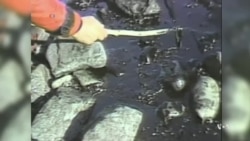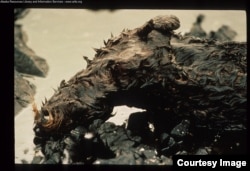In the early morning hours of March 24, 1989, a huge tanker sailed from Valdez at the terminus of the Trans-Alaska Pipeline into Prince William Sound. The Exxon Valdez struck a reef and spilled 41.5 million liters of crude oil.
Twenty-five years ago, it was largest oil spill in U.S. history, overtaken in 2010 by the BP Deep Water Horizon rig accident in the Gulf of Mexico. Still, Exxon Valdez holds the dubious distinction as the nation’s greatest environmental disaster from an oil spill and marked a turning point in the prevention of and response to such accidents.
Community in shock
Oceanographer Debbie Payton was called to Alaska a few hours after the spill by the National Oceanic and Atmospheric Administration (NOAA). She discovered a community in shock.
“At the town meeting, I would describe it as chaos, confusion," Payton said. "People [were] upset because of a lack of information. How could this happen in our very pristine backyard?”
Payton's job was to help predict where the oil would go. On Day One, she saw the eerie black sheen on Prince William Sound. Three days later, a storm picked up, and over the next weeks and months the oil spread to beaches and coves along the rocky coastline.
“There were oiled birds," she recalled. "There were some marine mammals that could be seen surfacing through the oil. There was oil on the beaches.”
Response teams used skimmers and booms. They burned the oil, deployed dispersants and sprayed steam on rocks. Recovery was slow, the location remote and the environmental loss staggering; hundreds of thousands of seabirds, sea otters, seals, bald eagles and whales were dead.
25 years later
Payton now heads NOAA’s Office of Response and Restoration, which has monitored the Exxon Valdez spill since the beginning. She says while pockets of oil are still visible, the coast and the fisheries appear healthy, with some notable exceptions.
“There are still some concerns with one of the fisheries, the herring fishery," she said.
The herring industry, once a thriving coastal business, has collapsed. One former fisherman - who didn’t give his name - bears the scars. He doubts herring will ever be fished commercially here again.
“Typically for the herring season we might have made $35,000, $40,000," he said. "Now nothing.”
The lawsuits filed against Exxon ended with a 2008 Supreme Court ruling, which capped punitive damages at $2.5 billion. While the company has spent over $4 billion - in compensation, cleanup payments, settlements and fines - critics allege that it is not enough. But Exxon Mobil spokesman Richard Keil told VOA it was a fair deal.
“We took immediate responsibility for the spill," Keil noted. "The payments we’ve made are based on agreements worked out in court with input from all parties. It’s also important to note that the company voluntarily compensated more than 11,000 Alaskans and businesses within a year of the spill.”
Safety changes
Keil says that the Exxon Valdez accident marked a low point, but also sparked a dramatic change in corporate culture to put safety first.
“It’s the number one factor guiding any and all business decisions we make," Keil said. "We want to protect the environment we’re operating in, the communities we’re part of and the employees, contractors and the people who live near our operations.”
Exxon Valdez was the impetus for other changes too, says NOAA’s Payton, starting with a new law, the Oil Pollution Act of 1990.
“It led to double hulled tankers," she said. "It led to community actions groups… better integration with response communities all the way from the oil spill response organizations, private entities, responsible parties through the state and federal government.”
Payton’s office responds to between 100 and 150 spills a year. She says a new generation of booms, skimmers and dispersants remain in NOAA’s arsenal, but the agency has added other tools, like an online data system, which records ocean currents and ship locations and predicts the path of oil in real time.
“And that allows us to just pull pieces of information together even quicker so that we can make decisions that much quicker,” she said.
Chuck Clusen, who heads Alaska Projects for the Natural Resources Defense Council, sees it another way, especially as the U.S. considers drilling in pristine areas of the Arctic.
“It’s a wake-up call for operations generally on the oceans involving oil," Clusen said. "The government and industry must take heed to that and understand that there are places simply we cannot go.”
If Exxon Valdez has taught us anything, Clusen says, it is to fairly weigh the ecological risk against the economic benefit of oil extraction.
Twenty-five years ago, it was largest oil spill in U.S. history, overtaken in 2010 by the BP Deep Water Horizon rig accident in the Gulf of Mexico. Still, Exxon Valdez holds the dubious distinction as the nation’s greatest environmental disaster from an oil spill and marked a turning point in the prevention of and response to such accidents.
Community in shock
Oceanographer Debbie Payton was called to Alaska a few hours after the spill by the National Oceanic and Atmospheric Administration (NOAA). She discovered a community in shock.
“At the town meeting, I would describe it as chaos, confusion," Payton said. "People [were] upset because of a lack of information. How could this happen in our very pristine backyard?”
Payton's job was to help predict where the oil would go. On Day One, she saw the eerie black sheen on Prince William Sound. Three days later, a storm picked up, and over the next weeks and months the oil spread to beaches and coves along the rocky coastline.
“There were oiled birds," she recalled. "There were some marine mammals that could be seen surfacing through the oil. There was oil on the beaches.”
Response teams used skimmers and booms. They burned the oil, deployed dispersants and sprayed steam on rocks. Recovery was slow, the location remote and the environmental loss staggering; hundreds of thousands of seabirds, sea otters, seals, bald eagles and whales were dead.
25 years later
Payton now heads NOAA’s Office of Response and Restoration, which has monitored the Exxon Valdez spill since the beginning. She says while pockets of oil are still visible, the coast and the fisheries appear healthy, with some notable exceptions.
“There are still some concerns with one of the fisheries, the herring fishery," she said.
The herring industry, once a thriving coastal business, has collapsed. One former fisherman - who didn’t give his name - bears the scars. He doubts herring will ever be fished commercially here again.
“Typically for the herring season we might have made $35,000, $40,000," he said. "Now nothing.”
The lawsuits filed against Exxon ended with a 2008 Supreme Court ruling, which capped punitive damages at $2.5 billion. While the company has spent over $4 billion - in compensation, cleanup payments, settlements and fines - critics allege that it is not enough. But Exxon Mobil spokesman Richard Keil told VOA it was a fair deal.
“We took immediate responsibility for the spill," Keil noted. "The payments we’ve made are based on agreements worked out in court with input from all parties. It’s also important to note that the company voluntarily compensated more than 11,000 Alaskans and businesses within a year of the spill.”
Safety changes
Keil says that the Exxon Valdez accident marked a low point, but also sparked a dramatic change in corporate culture to put safety first.
“It’s the number one factor guiding any and all business decisions we make," Keil said. "We want to protect the environment we’re operating in, the communities we’re part of and the employees, contractors and the people who live near our operations.”
Exxon Valdez was the impetus for other changes too, says NOAA’s Payton, starting with a new law, the Oil Pollution Act of 1990.
“It led to double hulled tankers," she said. "It led to community actions groups… better integration with response communities all the way from the oil spill response organizations, private entities, responsible parties through the state and federal government.”
Payton’s office responds to between 100 and 150 spills a year. She says a new generation of booms, skimmers and dispersants remain in NOAA’s arsenal, but the agency has added other tools, like an online data system, which records ocean currents and ship locations and predicts the path of oil in real time.
“And that allows us to just pull pieces of information together even quicker so that we can make decisions that much quicker,” she said.
Chuck Clusen, who heads Alaska Projects for the Natural Resources Defense Council, sees it another way, especially as the U.S. considers drilling in pristine areas of the Arctic.
“It’s a wake-up call for operations generally on the oceans involving oil," Clusen said. "The government and industry must take heed to that and understand that there are places simply we cannot go.”
If Exxon Valdez has taught us anything, Clusen says, it is to fairly weigh the ecological risk against the economic benefit of oil extraction.









